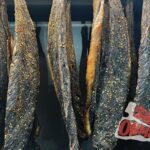We all know beef, game, and ostrich are the most traditional meats used for biltong, yet there’s an intriguing meat choice that has been gaining attention (thanks to the Aussies) – Kangaroo Biltong.
While this might sound like an unusual choice, all the key elements for fantastic biltong can be attributed to kangaroo meat; It is extremely lean, has long muscle fibres and is an inexpensive cut. So can you make biltong from kangaroo meat and if so, does it taste good?
In this blog post, we’ll dive into the unusual meat choice of Kangaroo for Biltong (Aussie game meat), exploring whether you can make biltong from kangaroo, what kangaroo tastes like, and we provide a step-by-step guide to crafting your own Kangaroo Biltong.
Can You Make Biltong From Kangaroo?
Kangaroo meat, Maybe you’ve tried it and loved it or heard of it and thought “Do people eat these cute animals?!”
In Australia we do, kangaroos are an emblem but also an overpopulated species that requires regular culling. The wonderful benefit of eating kangaroo is that it is highly sustainable, and it is beyond organic (in Australia all kangaroo is wild caught). So now you know, One question that may come to mind is whether kangaroo meat is suitable for making biltong.
Yes, you can make biltong from kangaroo meat. Biltong is a versatile preservation technique, and while it traditionally uses beef and game meat, kangaroo offers a unique and flavourful alternative. Kangaroo meat is lean, with a distinctive taste that can add a new dimension to the traditional biltong flavour.
When making biltong from kangaroo, it’s essential to consider the lean nature of the meat. Kangaroo meat has less fat compared to some other meats used for biltong. This means that the curing and marinating process may need slight adjustments to ensure the meat remains tender and flavourful throughout the drying process.

Here are some key points to keep in mind when making biltong from kangaroo:
- Choose High-Quality Kangaroo Meat: Ensure that the kangaroo meat you use is fresh, free from additives, and sourced from a reputable supplier. High-quality meat is essential for a delicious end product.
- Adjust the Curing Process: Kangaroo meat benefits from a slightly different curing process due to its leanness. Consider adjusting the marinating time and ingredients to enhance the flavours and maintain the tenderness of the meat.
- Experiment with Flavors: Kangaroo meat has a unique taste that can be complemented by various spices and flavourings. Experiment with different marinades to find the combination that suits your palate.
- Monitor Drying Time: Since kangaroo meat is leaner than some other options, it may dry more quickly. Keep a close eye on the drying process to prevent over-drying, which can result in a tough texture.
- Slice Thinly for Even Drying: To ensure even drying, slice the kangaroo meat thinly. This not only aids in the drying process but also allows the flavours to penetrate the meat more effectively.
- Consider Preparing a Test Batch: If you’re new to making kangaroo biltong, consider preparing a smaller test batch before making a larger quantity. This allows you to fine-tune the process and adjust flavours to your liking.

What Does Kangaroo Taste Like?
Kangaroo meat has a distinct taste that’s often described as gamey, with a slightly sweet and nutty undertone. Kangaroo is a wild game meat, and its taste reflects its natural, free-range lifestyle.
It’s lean meat, meaning it has a low-fat content, which contributes to its unique flavour profile. This leanness gives it a clean and pure taste, allowing the meat’s natural flavours to shine through without the richness associated with fattier cuts.
Many people compare the taste of kangaroo to venison, with a robust, earthy flavour that’s not too overpowering. While other people note a subtle sweetness in kangaroo meat, especially when compared to other game meats.
When prepared correctly, kangaroo meat can be tender and succulent. Proper marination and cooking methods help maintain the tenderness of the meat, ensuring an enjoyable eating experience.
Is Kangaroo Biltong Good For You?
Biltong made from kangaroo meat, offers a range of health benefits. Here are some reasons why incorporating kangaroo biltong into your diet might be a wise choice:
- Low in Fat: Kangaroo meat is low in fat, making it a heart-healthy option. It’s an excellent choice for those looking to reduce their fat intake while still enjoying a protein-packed snack.
- High in Protein: Just like traditional biltong, kangaroo biltong is a fantastic source of high-quality protein. Protein is essential for muscle repair and overall health, making kangaroo biltong a nutritious snack for active individuals.
- Rich in Iron and Zinc: Kangaroo meat is a good source of iron and zinc, essential minerals for maintaining a healthy immune system and promoting overall well-being.
- Low in Calories: If you’re watching your calorie intake, kangaroo biltong can be a satisfying snack without the guilt. Its low-fat content contributes to a lower calorie count than other meats.
- Omega-3 Fatty Acids: Kangaroo meat contains omega-3 fatty acids, which are beneficial for heart health. Including kangaroo biltong in your diet can contribute to a well-rounded intake of essential nutrients.

Kangaroo Biltong Recipe: Step By Step
Now that we’ve explored the idea of making biltong from kangaroo and highlighted its unique flavour and health benefits, let’s delve into a step-by-step guide to crafting your own Kangaroo Biltong.
Ingredients:
- 1 Kilogram of kangaroo meat, thinly sliced
- 1 cup of vinegar (brown or apple cider vinegar)
- 1 cup of Worcestershire sauce
- 2 tablespoons of coarse salt
- 2 tablespoons of ground black pepper
- 1 tablespoon of toasted coriander seeds, crushed
- 1 tablespoon of brown sugar (optional, for a hint of sweetness)
- 1 teaspoon of garlic powder
- 1 teaspoon of onion powder
Instructions:
- Prepare the Meat:
- Ensure the kangaroo meat is thinly sliced for even drying (no more than 3 cm thick)
- It is common in supermarkets to find kangaroo ready sliced (with the grain) into steaks, this is perfect and an easy option.
- Create the Marinade:
- In a bowl, mix the vinegar, Worcestershire sauce, salt, black pepper, crushed toasted coriander seeds, brown sugar (if using), garlic powder, and onion powder.
- Marinate the Meat:
- Place the kangaroo slices in a shallow dish or a zip-top bag.
- Pour the marinade over the meat, ensuring each piece is well-coated.
- Seal the container or bag and refrigerate for at least 4 hours, or preferably overnight, to allow the flavours to penetrate the meat.
- Remove Excess Marinade:
- Take the marinated kangaroo slices out of the refrigerator and drain off any excess marinade.
- Pat dry with paper hand towels so there are no drips.
- Prepare For Hanging:
- Take each piece of meat and thread an S hook or paper clip bent into an S through the top of the meat.
- Dry the Biltong:
- Hang your strips of marinated kangaroo in your biltong box or well-ventilated area (ensure no pieces are touching)
- Check the biltong every day from day 2-day to 7 until you are happy with the level of dryness
- Enjoy:
- Once dried, slice your kangaroo biltong against the grain into bite-sized pieces.
Kangaroo Biltong presents a delightful twist on the classic South African snack, offering a lean, flavorful, and nutritious alternative for those seeking something a bit different. So, why not give Kangaroo Biltong a try and see if its your new favourite alternative?
Biltong Brainiac: Test Your Dried Meat IQ

Recent Posts:
- The Truth About Beef Jerky And Your Health
 A favourite among outdoor enthusiasts for its transportability, for fitness enthusiasts for its …
A favourite among outdoor enthusiasts for its transportability, for fitness enthusiasts for its … - Kangaroo Biltong: How To Make It
 We all know beef, game, and ostrich are the most traditional meats used …
We all know beef, game, and ostrich are the most traditional meats used … - What Is Biltong? Everything You Need To Know
 In the world of savoury snacks, one delicacy stands out for its unique …
In the world of savoury snacks, one delicacy stands out for its unique …





